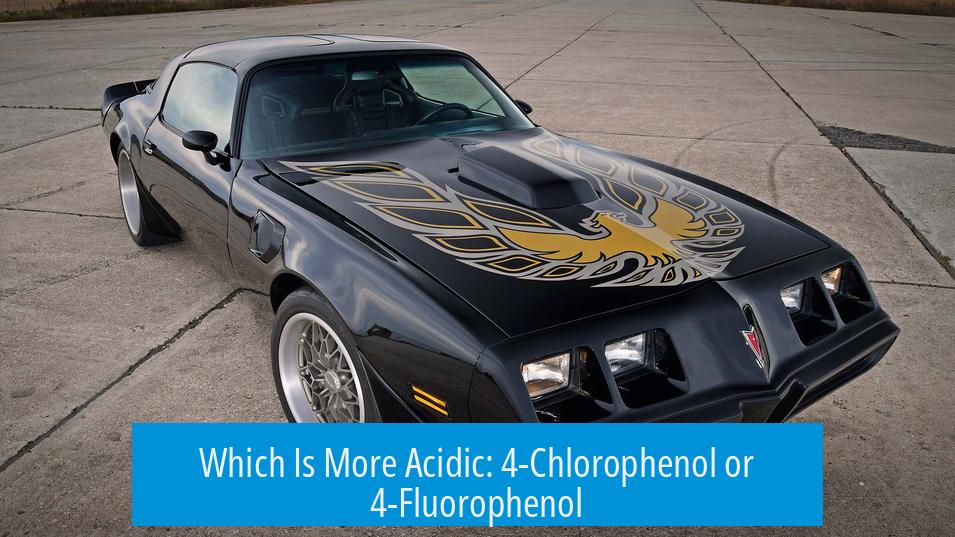Which Is More Acidic: 4-Chlorophenol or 4-Fluorophenol?

4-Chlorophenol is more acidic than 4-fluorophenol. This conclusion stems from the detailed electronic effects that chlorine and fluorine exert on the phenol ring, especially their influence on the conjugate base stability after deprotonation.
Electronic Influence on Acidity
The acidity of phenols depends mainly on how well the substituent stabilizes the negative charge on the oxygen after losing a proton.
- Chlorine (Cl) is a strong σ-electron withdrawing group but a weak π-donor. It effectively stabilizes the conjugate base by pulling electron density away through the sigma framework without donating electron density back via resonance.
- Fluorine (F) acts as both a σ-acceptor and a good π-donor. It donates electron density back to the ring via resonance overlap with its p orbitals, which destabilizes the conjugate base relative to chlorine’s effect, reducing acidity.
Position and Resonance Effects
At the para position, these effects are most distinct. Fluorine’s resonance donation negates some of its inductive withdrawal, lowering acidity compared to chlorine.
If the substituents were meta, resonance effects are minimized, and both substituents’ acidity effects would resemble their electron-withdrawing inductive powers, showing less difference.
Supporting Evidence and Concepts
- The sigma minus (σ–) values from Hammett constants directly quantify the electron-withdrawing power. Chlorine’s σ– value is higher, confirming it withdraws electrons more strongly inductively.
- The ARIO framework (Atom, Resonance, Induction, and Orbital) supports that chlorine better stabilizes the conjugate base’s negative charge.
Common Misconceptions
Initial intuition often favors fluorine as more acidic because it is more electronegative. However, fluorine’s strong π-donation counteracts this effect in para-substituted phenols.
Chlorine’s less effective resonance donation but stronger sigma withdrawal makes it superior at increasing acidity in this context.
Key Takeaways
- 4-Chlorophenol is more acidic than 4-fluorophenol.
- Chlorine’s strong σ-withdrawing effect stabilizes the conjugate base better.
- Fluorine’s π-donation reduces its overall acidity enhancement at the para position.
- Hammett sigma constants confirm chlorine’s stronger electron-withdrawing inductive effect.
- Position on the aromatic ring affects resonance influence on acidity.
So, which one wins the acidity showdown: 4-Chlorophenol or 4-Fluorophenol?
If you’re scratching your head wondering which is more acidic between 4-chlorophenol and 4-fluorophenol, you’re not alone. It can *feel* like fluorine should take the crown because it’s more electronegative, but surprisingly, the answer is 4-chlorophenol is more acidic than 4-fluorophenol. Let’s unpack this with some chemistry wizardry, shall we?
A Quick Recap of What Acidity Means Here
Acidity for phenols basically boils down to how easily they can lose a proton (a hydrogen ion). The trick? How stable the leftover molecule (called the conjugate base) is after losing that proton. More stable conjugate base = stronger acid.
Cl vs. F: The Tale of Two Halogens
At first glance, fluorine’s high electronegativity screams “acid booster.” But acidity isn’t just about electronegativity. We’ve got electron-withdrawing and electron-donating effects fighting it out.
- Chlorine (Cl) is a strong σ-withdrawing group, meaning it pulls electron density away through sigma bonds, which stabilizes the conjugate base’s negative charge effectively.
- Fluorine (F) is interesting because it simultaneously withdraws electrons by sigma (σ) bonds but *donates* electrons through π-donation (due to its unique overlap of orbitals with the phenyl ring).
This π-donation by fluorine pumps electron density back into the ring. Result? The negative charge on the conjugate base gets less stabilized, making the acid weaker than you might expect.
Electron Withdrawing Power: Not Just Electronegative, But Also Position Matters
The effect varies with position. Here, we’re talking about the para position (the 4- position). If Cl and F substituted phenols were in the meta position, the story would tilt differently because resonance effects that allow π-donation from F wouldn’t play as strong a role. That would level their acidity values more.
But since both are in the para position, chlorine’s inability to donate electrons through π-interactions actually becomes its winning edge.
Why Does Chlorine Win? The ARIO Rule and Conjugate Base Stability
One way to decipher acidity is to look at the conjugate base using the ARIO acronym:
- Atom: Electronegativity of the atom bearing the negative charge.
- Resonance: Can the negative charge be delocalized?
- Inductive effect: Electron withdrawing/donating effects of substituents.
- Orbitals: Which orbital holds the negative charge (s, p, etc.)?
In this comparison, chlorine does a better job at stabilizing the negative charge after proton loss (“O” and “I”), mainly due to its strong sigma-withdrawing effect combined with poor π-donation. This makes the conjugate base of 4-chlorophenol more stable.
Hammett Sigma Constants: Your New Best Friend in Acidity Prediction
To get extra scientific (and maybe impress your chemistry pals), you can look at Hammett sigma constants, which quantify how substitutions affect acidity through their electron-withdrawing or donating abilities.
For para substituents:
| Substituent | Hammett Sigma Constant (σp) |
|---|---|
| 4-Chloro | +0.23 (stronger electron withdrawing) |
| 4-Fluoro | +0.06 (weaker electron withdrawing; more resonance donation) |
Higher sigma values usually mean stronger acidity, confirming chlorine’s edge here.
Wait, but What About Size and Periodic Trends?
Sometimes we fall back on simple heuristics like “same row, electronegativity wins” or “same column, size wins.” Here, chlorine and fluorine are in the same period (row), so electronegativity would suggest fluorine is stronger. But this rule misses the critical nuances of π-donation and resonance.
Chlorine is larger and less electronegative than fluorine but pulls electrons better via sigma bonds and doesn’t push them back in via π-donation, tipping the acidity in favor of chloro-substituted phenol.
Feeling Conflicted? You’re Not Alone!
“I get the feeling like this is one where your gut reaction wants to immediately say the fluoro but it’s actually going to be chloro.”
Yep, many chemists initially think fluorophenol would be more acidic—fluorine’s electronegativity is a siren call. But deeper analysis and experimental data side with chlorine. It’s a perfect example of why chemistry is never just about one factor. The dance of electrons makes the difference.
Practical Tips for Remembering This
- When in doubt, remember to consider both sigma and pi effects. Halogens are tricky because they can donate and withdraw.
- Use tools like Hammett constants and ARIO when evaluating acidity or similar questions.
- Watch out for the position of the substituent on the ring—ortho, meta, and para matter greatly.
Wrapping Up: Which is More Acidic?
To cut through the confusion, here is the final verdict:
4-chlorophenol is more acidic than 4-fluorophenol. Chlorine’s stronger sigma-withdrawing nature and poor π-donation stabilize the conjugate base better than fluorine’s mix of sigma-withdrawal and pi-donation. This stability of the conjugate base is exactly what strengthens an acid.
This conclusion aligns with theoretical constants, experimental evidence, and conceptual acidity tools. It also reveals how subtle electronic effects can flip intuitive answers on their heads.
Final Food for Thought
Next time someone says, “Fluorine makes things more acidic because it’s more electronegative,” you can confidently reply, “Not always! Sometimes, chlorine’s got a better game plan in electron withdrawal.” Chemical reality always has richer layers than first meets the eye.
Which is more acidic, 4-chlorophenol or 4-fluorophenol?
4-chlorophenol is more acidic than 4-fluorophenol. Chlorine’s stronger sigma-withdrawing effect stabilizes the conjugate base better.
Why does chlorine increase acidity more than fluorine in phenols?
Chlorine is a strong sigma-withdrawing group but a poor pi-donor. It stabilizes the negative charge after deprotonation without pushing electron density back into the ring.
How does fluorine’s electron donation affect its acidity?
Fluorine donates electron density through pi-donation, which reduces the acidity by destabilizing the conjugate base.
Can the position of substituents change the acidity trend?
Yes. In the meta position, the acidic strengths of 4-chlorophenol and 4-fluorophenol become similar due to reduced resonance effects.
What tools help predict acidity differences between substituted phenols?
Using Hammett sigma constants and assessing conjugate base stability with the ARIO approach can clarify acid strength trends.





Leave a Comment